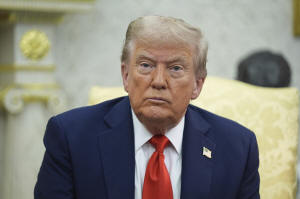Trump asks Supreme Court to quickly take up tariffs case and reverse
ruling finding them illegal
[September 04, 2025]
By LINDSAY WHITEHURST
WASHINGTON (AP) — The Trump administration took the fight over tariffs
to the Supreme Court on Wednesday, asking the justices to rule quickly
that the president has the power to impose sweeping import taxes under
federal law.
The government called on the court to reverse an appeals court ruling
that found most of President Donald Trump’s tariffs are an illegal use
of an emergency powers law.
It's the latest in a series of Trump administration appeals to a Supreme
Court he helped shape, and one that is expected to put a centerpiece of
the president's trade policy before the justices.
The U.S. Court of Appeals for the Federal Circuit left the tariffs in
place for now, but the administration nevertheless called on the high
court to intervene quickly in a petition filed electronically late
Wednesday and provided to The Associated Press. It was expected to be
formally docketed on Thursday.
Solicitor General D. John Sauer asked the justices to take up the case
and hear arguments in early November.
“That decision casts a pall of uncertainty upon ongoing foreign
negotiations that the President has been pursuing through tariffs over
the past five months, jeopardizing both already negotiated framework
deals and ongoing negotiations,” he wrote. “The stakes in this case
could not be higher.”
But the stakes are also high for small businesses battered by tariffs
and uncertainty, said Jeffrey Schwab, senior counsel and director of
litigation at the Liberty Justice Center.

“These unlawful tariffs are inflicting serious harm on small businesses
and jeopardizing their survival. We hope for a prompt resolution of this
case for our clients,” he said.
The businesses have twice prevailed, once at a federal court focused on
trade and again with the appeals court's 7-4 ruling.
Their lawsuit is one of several challenging the tariffs and erratic
rollout that have shaken global markets, alienated U.S. trading partners
and allies and raised fears of higher prices and slower economic growth.
[to top of second column]
|

President Donald Trump listens during a meeting with Polish
President Karol Nawrocki in the Oval Office of the White House,
Wednesday, Sept. 3, 2025, in Washington. (AP Photo/Evan Vucci)

But Trump has also used the levies to pressure the European Union,
Japan and other countries into accepting new trade deals. Revenue
from tariffs totaled $159 billion by late August, more than double
what it was at the same point the year before.
Most judges on the U.S. Court of Appeals for the Federal Circuit
found the 1977 International Emergency Economic Powers Act, or IEEPA,
did not let Trump usurp congressional power to set tariffs. The
dissenters, though, said the law does allow the president to
regulate importation during emergencies without explicit
limitations.
The ruling involves two sets of import taxes, both of which Trump
justified by declaring a national emergency: the tariffs first
announced in April and the ones from February on imports from
Canada, China and Mexico.
The Constitution gives Congress the power to impose taxes, including
tariffs. But over the decades, lawmakers have ceded authority to the
president, and Trump has made the most of the power vacuum.
Some Trump tariffs, including levies on foreign steel, aluminum and
autos, weren’t covered by the appeals court ruling. It also does not
include tariffs Trump imposed on China in his first term that were
kept by Democratic President Joe Biden.
Trump can impose tariffs under other laws, but those have more
limitations on the speed and severity with which he could act.
The government has argued that if the tariffs are struck down, it
might have to refund some of the import taxes that it’s collected,
delivering a financial blow to the U.S. Treasury.
All contents © copyright 2025 Associated Press. All rights reserved |